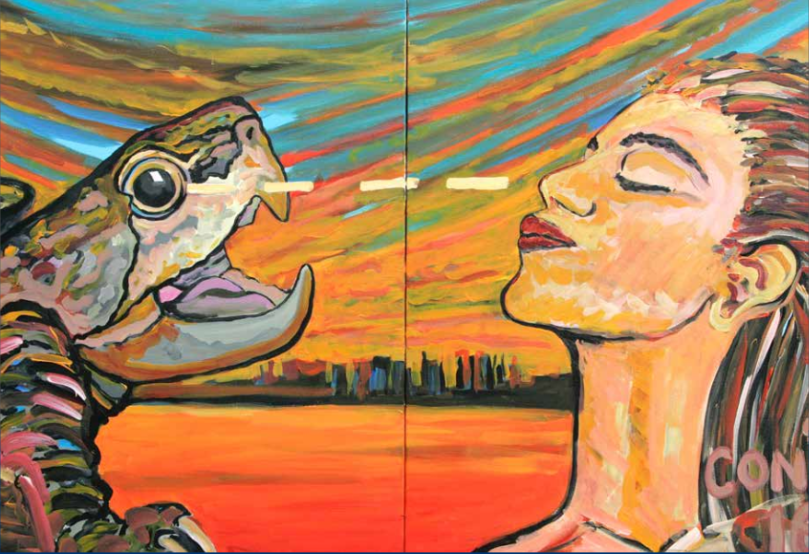The Portfolio
Coni’s “Impact Art” is impressive for the emotions generated by the colours, forms and contrasts it contains, as well as the lyrical and dramatic elements perceptible in his images.
Inspired by Jean-Michel Basquiat, he began to create his works as far back as four years ago, combining two different visual languages. While the first is realistic and figurative, the other is abstract and expressive, and he has thus developed a style that is completely his own. His works stand out for their communicative function. Through the artwork, the interventions of the protagonists (which are invariably turtles, in the role of nature’s survival artists) allow us to enter the day-to-day experience of these animals, which is often difficult, while simultaneously setting the mood for the subject matter of Coni’s works.
His primary interest lies in awakening humanity’s awareness of our environment. In a wider context, Coni asks himself these questions: “Who will die out first: people or animals?” and “Could evolution, which often happens erratically and randomly, have happened differently?”. The hybrid beings created by Coni started to appear from 2018 onwards, as if they had sprung forth out of a surreal dreamscape, the creatures of a new and yet somehow familiar species.


#1
Who lives longer
Who dies first
This picture is neither about a skull nor about death.
No, this is about a simple question that can rarely be answered, even by those people who study the subject of evolution.
It is the visualisation of a question and the necessity of stirring something in the human body of thought.


#2
My enemies have changed
For a period of almost 200 million years, I was attacked only by animals. My ancestors were often eaten by dinosaurs, but also sometimes by sharks. The dinosaurs died out about 60 million years ago and I was left in peace ... until human beings appeared and the whole world changed. I have a new enemy now.



#3
At eye level
In human psychology, we understand the phrase “seeing eye to eye” as an indication of equal status.
This visual image shows that this imagery could also work with the turtle, but the woman has closed her eyes.
Humans normally only see reptiles from above; if eye levels don’t match, the consequence is a lack of respect.


#4
Living together
Unlike animals, humans have an awareness of the past, the present and the future.
We know what we might be able to achieve through our actions, but are we also conscious of what we can destroy in the process? Is it possible to live with the people on this planet? The world is grey, but the turtle still retains a few spots of colour and glimmers of light.


#5
Do you have a future
A question asked of the rhino by the turtle, because rhino horn powder continues to be prescribed in Asia for erectile dysfunction. However, this question could just as easily have been asked the other way round; turtles continue to be used in Asian cuisine as well as traditional medicine, and are consumed by the tonne. In many cultures, turtles are regarded as a symbol of a long life, strength and stamina. However, this position of high esteem is increasingly leading to their downfall in East and South East Asia. A belief that the positive characteristics of the animal may be transferred to the people who eat their flesh, crushed bones or shells is leading to the threat of extinction for turtles in many Asian countries.


#6
Gui Tou
In the Chinese language, this word has different meanings: “gui tou” stands for the head of a penis as well as the head of a turtle. The artist is fascinated by the huge importance of this animal in Asian nations. Turtles represent long life, wisdom and steadfastness. They are often depicted as the Bearer of the World; they embody Mother Earth, the beginning of Creation and are a sign of fertility and regeneration. In ancient times, turtle shells were used to help predict the future. Holes were pre-drilled into turtle shells and burned out, then the future was divined from the fissures that appeared on the underside of the shell. The texts of the oracles were scratched onto the shells, and remain an important historical source on the oldest era of China to this day.


#7
Ivory
At first glance, this is a wonderfully harmonious image of two young animals.
The message comes to us when we take a second look.
#7
Ivory
At first glance, this is a wonderfully harmonious image of two young animals.
The message comes to us when we take a second look.





























